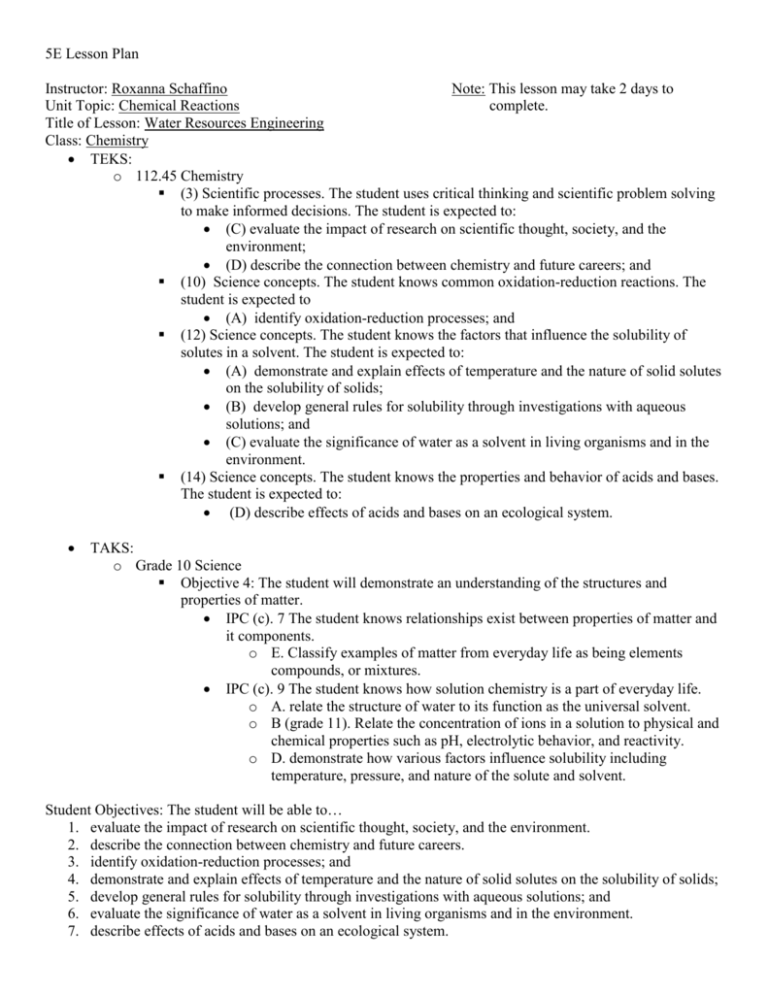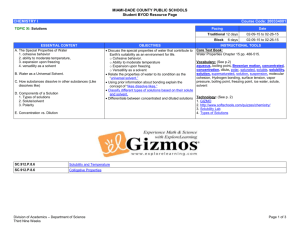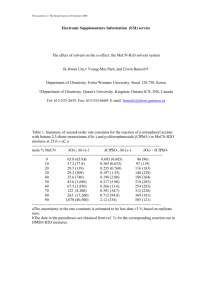water_re
advertisement

5E Lesson Plan Instructor: Roxanna Schaffino Note: This lesson may take 2 days to Unit Topic: Chemical Reactions complete. Title of Lesson: Water Resources Engineering Class: Chemistry TEKS: o 112.45 Chemistry (3) Scientific processes. The student uses critical thinking and scientific problem solving to make informed decisions. The student is expected to: (C) evaluate the impact of research on scientific thought, society, and the environment; (D) describe the connection between chemistry and future careers; and (10) Science concepts. The student knows common oxidation-reduction reactions. The student is expected to (A) identify oxidation-reduction processes; and (12) Science concepts. The student knows the factors that influence the solubility of solutes in a solvent. The student is expected to: (A) demonstrate and explain effects of temperature and the nature of solid solutes on the solubility of solids; (B) develop general rules for solubility through investigations with aqueous solutions; and (C) evaluate the significance of water as a solvent in living organisms and in the environment. (14) Science concepts. The student knows the properties and behavior of acids and bases. The student is expected to: (D) describe effects of acids and bases on an ecological system. TAKS: o Grade 10 Science Objective 4: The student will demonstrate an understanding of the structures and properties of matter. IPC (c). 7 The student knows relationships exist between properties of matter and it components. o E. Classify examples of matter from everyday life as being elements compounds, or mixtures. IPC (c). 9 The student knows how solution chemistry is a part of everyday life. o A. relate the structure of water to its function as the universal solvent. o B (grade 11). Relate the concentration of ions in a solution to physical and chemical properties such as pH, electrolytic behavior, and reactivity. o D. demonstrate how various factors influence solubility including temperature, pressure, and nature of the solute and solvent. Student Objectives: The student will be able to… 1. evaluate the impact of research on scientific thought, society, and the environment. 2. describe the connection between chemistry and future careers. 3. identify oxidation-reduction processes; and 4. demonstrate and explain effects of temperature and the nature of solid solutes on the solubility of solids; 5. develop general rules for solubility through investigations with aqueous solutions; and 6. evaluate the significance of water as a solvent in living organisms and in the environment. 7. describe effects of acids and bases on an ecological system. Materials: Soil Profile handout Enough of the following materials for each student: o Clear plastic cups o Spoons o Rice Crispy Treats o M & M’s o Peanut Butter o Crushed Chocolate Graham Crackers o Shredded Coconut Overhead/Computer o Transparencies/Power Point Presentation I. Engagement: This should puzzle and motivate students in activity or lesson. You will need a focus activity/question to engage students in the task/assignment at hand. Focus Questions: What is engineering? (general) What is water resources engineering? (specific) II. Exploration: This should allow students to explore today’s topics. You will need a task/assignment/lab that allows student to work individually or in small groups with little or no help from the instructor. Soil Profile Activity Students work individually The students will receive a hand out to build their own soil profile Allow 2-3 minutes to read/explain the hand out prior to starting the profile Allow 7-9 minutes to complete the profile III. Explanation: This allows for focusing/narrowing in on today’s objectives. Have students present/discuss their observations of the topic. Class Discussion What observations did students make? Discuss as a class. Key Point during discussion should be observation made when colored water was trickled down the profile. o For instance, on what layer did the colored water seem to stop? Why? Answer: Students should have noticed that the colored water seemed to stop trickling down once it got to the peanut butter representative of the B horizon. The B horizon, combined with the O, A, and E horizons make up a region of the soil known as the solum, which means true soil. The B horizon is the Zone of Accumulation where chemicals leached out of the topsoil accumulate. It is has a higher content of clay (particle size, 0.002 mm). Furthermore, most of the roots of the plants grow in the solum. Write down (as a class) the different crops that are grown in the Rio Grande Valley. o Corn, sugarcane, carrots, palm trees, cabbage, onions, oranges, watermelons, etc. o Use sugarcane as the prime example since the excel spreadsheet uses sugarcane as the example. Key Point: Valley agriculture is important to the economy. Transition into Water Resources Planning Engineering. Teacher narrows in on objectives: Factual info (mainly from Background Information): o Discuss the importance of water to crops. How do we determine the amount of irrigation supplied according to amount of rainfall? What happens if there is a lot of rain or not enough? The amount of water is critical to the crop yield. ~Show the students the “Crop Water Production Function” and “Net Profit Water Function” Excel spreadsheet. o Chemistry: What happens when farmers supply sufficient water but harvest a poor quality crop? Insufficient plant nutrients may be the issue. Miscellaneous: o Irrigation Furrow- Main irrigation utilized in the Valley. Why? Furrow irrigation is mainly used in areas where the land is level (flat) or where the slopes are smooth. Also, furrow irrigation is used for row crops. Move into irrigation and delivery of ions to be absorbed by the soil and crops. Other Types of Irrigation: Trickle, Sprinkler, Basin, and Border. IV. Elaboration: Allow students to comprehend and apply the information. You will need a homework, worksheet, etc. to assign Homework: Magic Square Activity (ions) Solubility Rules/Oxidation Number worksheet Closure: What do you think about engineering now? V. Evaluate: Allow students to demonstrate knowledge and comprehension of objectives. Plan for a future test/quiz over these objectives. Quiz: Solubility Rules Oxidation Numbers Supplement in the Rio Grande Valley: Field Trip: The Texas A&M Agriculture Research and Extension Center in Weslaco, Texas. OR Rio Grande Valley Sugar Growers Inc. in Santa Rosa, Texas References: Ebbing, D. and S. Gammon. General Chemistry, Seventh Ed. Boston: Houghton Mifflin Company, 2002. Harpstead, M.; T.J. Sauer; and W.F. Bennett. Soil Science Simplified. Fourth Ed. Iowa State Univeristy Press, 2001. Kohnke, H. and D.P. Franzmeier. Soil Science Simplified. Fourth Ed. Prospect Heights: Waveland Press Inc., 1995.





